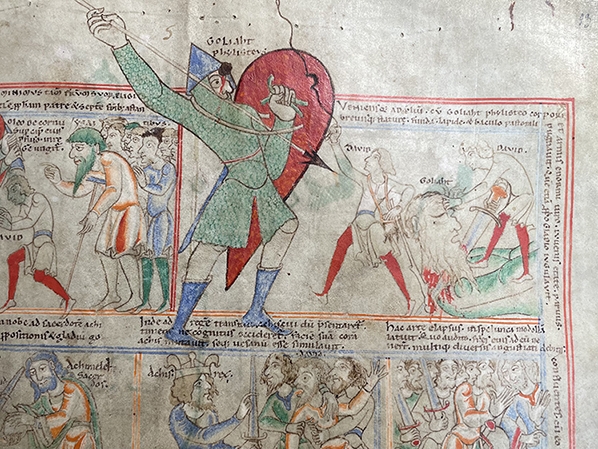“David and Goliath.” It’s a tale as old as time, or at least as old as the Bible.
But age hasn’t dimmed its magnetism. “David and Goliath” is still a story that’s hard to put down – especially when it’s told through pictures.
Alex Roginski ’26 knows this only too well. They are conducting research on graphic narratives, specifically two retellings of “David and Goliath.” One is modern. The other, medieval.
In 2012, cartoonist Tom Gauld published the graphic novel, Goliath. And in the 12th century, St. Steven Harding included a comic strip-like version of “David and Goliath” in what is today known as the Bible of St. Steven Harding. It is housed in Bibliothéque muncipale de Dijon (France), which Roginski visited this summer as part of their research.
Roginski is comparing the two works, studying the relationship between illuminated medieval manuscripts and contemporary graphic novels.
“The Bible of St. Steven Harding is known for striking illustrations, some of which are arranged in a comic strip format to tell the story of King David,” Roginski said. “This demonstrates that comics are not a recent invention, but rather have been developed over the course of centuries.
“Despite changes in mindset, art style and intentions, comic strips continue to rework our cultural stories -- such as ‘David and Goliath’ -- and showcase the many ways we can retell stories and why we bother.”
Below, Roginski, a double major in English and physics, expands on why we tell stories over and over. They also share what inspired their research and what they have learned so far. (Roginski’s faculty advisor for their summer work is Assistant Professor of History Sarina Kuersteiner.)
Why did you choose to study the story of “David and Goliath?”
When I started this project, I was researching the history of graphic narratives and stumbled upon a distinct image from the Bible of St. Steven Harding. It was part of a page about the life of King David – everything from him killing Goliath to being crowned king. The page is organized like a comic strip, complete with miniature figures, bright colors, illumination and some text to explain the events depicted. It just really delighted me. Goliath is so large that he bursts out of the panel. St. Steven Harding originally intended his manuscript as a learning tool for the monks at Citeaux Abbey and attempted to preserve all biblical stories with original meanings and themes.
Associate Professor of English Judith Lewin pointed me towards Gauld’s Goliath. His graphic novel is written from Goliath’s perspective. Instead of being the all-powerful figure from the biblical story, Goliath is timid and uninterested in fighting. It was intriguing how Gauld, in reversing the narrative, created a novel that forces readers to reconsider their stances. Gauld did the opposite of Harding, and I wanted to analyze that and explore how “David and Goliath” has changed over the course of different retellings.
What’s the difference between graphic novels and comics? Is it simply length?
In terms of my research, yes. A graphic novel tends to have one long narrative, while a comic strip tends to be short and is often funny, as the word comic implies. The graphic narrative in the Bible of St. Steven Harding only lasts 15 panels over the course of one page, so it is a comic strip, though I refer to it as a graphic narrative to avoid the humorous implications of a comic strip.
What have you learned so far about how Gauld and Harding present the story of “David and Goliath?” What are the similarities and differences?
St. Steven Harding retold the story as true to the biblical version as possible, while Tom Gauld flipped the narrative. Harding wanted to teach his fellow monks the biblical stories most relevant to their faith, as well as emphasize the story’s importance by dedicating time, effort and expense into illustration and illumination. Gauld wanted to teach his contemporary readers the importance of perspective and bias. But while their aims are different, these men are similar in that they both desire to teach the importance of retellings and urge their audiences to learn.
What do societies and people gain from retelling stories? Why do we do it?
We have unlimited opportunity to experiment and create new stories from old ones to reflect new meaning or teach new ideas. In doing so, we start to see the ways we have changed over time, and we can compare how present or past ideals are reflected in the retellings that emerged at the time. I find retellings to be an incredible opportunity to explore the ways we’ve changed and grown, and I believe retellings to be authors asking for their readers to change and grow.
What might we today gain from the retelling of “David and Goliath?”
Personally, I find the original story of “David and Goliath” extremely relevant to our current political and economic situation. We live in a world dominated by powerful organizations, and it’s important to be reminded that even one person can make a difference. I also find that Gauld’s retelling is relevant, because it’s also important to remember how everyone has a different perspective and story, and that all stories are told with bias. Both stories are valuable to us and to each other because they share different messages, showcasing the impact of various retellings.

